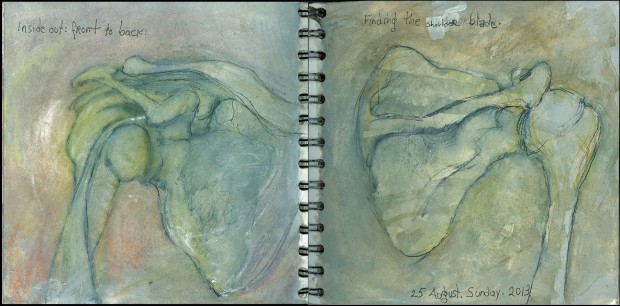Sketchblog: DayBooks
Why draw the shoulder blades, yet again?
I don’t know: there’s something compelling about the shoulder blades, About how they flatten onto the back, eking out their existence among the muscles and fascia. About how they can almost disappear in side view but spread out facing front or back, giving expression and stability to the movements of the arm. I always think of movement unwinding from the shoulder and then circling back.
It’s easy enough to sense the contours of your own shoulder (and even feel those contours against a tennis ball, or even with fingers if you have the reach or at distance, rolling against a tennis ball), The front face is lost in thought though, in tissue. once you go beyond the distinct surfaces of the clavicle.
The shoulder is really hard to draw in profile — at least for me, rooted as I generally am to the bone. It can be done (the profile view), and I’ve tried, with mixed success, but the bone itself gets a really flat curve. And my sense of anatomy is mostly more hard-core. Okay, I’ll do ligaments now and then (hard to manage the coracoid without one or two, and I admit to a growing enthusiasm for the coracoid), maybe the occasional muscle (like a bicep) or a tendon. I’m not as interested (or at least not for the moment, or the year) in the interweaving that actually makes the full realization of movement possible.
Organs somehow seem to inhabit a sphere of their own. Oh, I’ve done the odd stomach, but that’s as far as I go. It’s the bones that point you to where you are in space, at least for some of us.

